for Ingenuity
ADOT, Ames Earn America’s Transportation Awards Honors



An Arizona Department of Transportation project that replaced the U.S. 60 Pinto Creek Bridge between the East Valley and Globe has received a regional honor.
The 2023 America’s Transportation Awards named the venture Best Use of Technology and Innovation, Medium Project, for the Western region. The competition is sponsored by AASHTO, as well as AAA and the U.S. Chamber of Commerce.


“We’re grateful to see the Pinto Creek Bridge replacement honored among projects throughout the West, but we’re even

see PINTO page 8
As part of the project, Ames built a temporary access road to the canyon floor for heavy equipment, including a 400ton crane that placed girders atop the bridge’s three piers, the tallest of which is 138 ft.


6382 West 2100 South, Salt Lake City, Utah 84128 • (801) 972-8939 • www.utahtrackandwelding.com • sam@utahtrackandwelding.com Specializing in New, Used & Rebuilt Replacement Parts • Undercarriage Parts • Attachments • New and Used Parts • Field Service • Full Service Shop • Track Repair • Equipment Sales • Hydraulic Cylinder Repair • Teeth & Edges We Buy Salvage Equipment Alternative to the dealer for all makes & models Utah Track & Welding Service & Sales
Vol. I • No. FOUR CORNERS STATES EDITION ® “The Nation’s Best Read Construction Newspaper… Founded in 1957.” Your Four Corners Connection • Dennis Hogeboom • 1-877-877-4997 • dennishogeboom@cegltd.com
The 2023 America’s Transportation Awards recognized the Arizona Department of Transportation and Ames Construction for its work on the U.S. 60 Pinto Creek Bridge, which was recently awarded the Best Use of Technology and Innovation, Medium Project, for the Western region.
‘A’
LOGAN, UT 453 North 1000 West Logan, UT 84321 435-752-1533

SALT LAKE CITY, UT 4343 Century Dr. Salt Lake City, UT 84123 801-262-5761
CEDAR CITY, UT 482 North Main Street Cedar City, UT 84720 435-586-4406 Email: del.maxedon@centuryeq.com

SPRINGVILLE, UT 1350 South 2000 West Springville, UT 84663 801-794-1463
CLIFTON, CO 549 32nd Rd. Clifton, CO 81520 970-434-7363
DURANGO, CO 1097 Hwy 3 Durango, CO 81301 970-247-0522
ALBUQUERQUE, NM 6301 Edith Blvd. NE Albuquerque, NM 87107 505-433-2246
Page 2 • July 2, 2023 • www.constructionequipmentguide.com • Four Corners States Supplement • Construction Equipment Guide

Construction Equipment Guide • Four Corners States Supplement • www.constructionequipmentguide.com • July 2, 2023 • Page 3 COLORADO Corporate Office 5000 Vasquez Blvd. Denver, CO 80216 303.355.5900 Grand Junction 970-241-1550 Colorado Springs 719.576.5541 Milliken 970.587.1188 Durango 970.259.0455 WYOMING Cheyenne 307.634.5149 NEW MEXICO Albuquerque 505.345.8383 Bloomfield 505.324.8601 Carlsbad 505.485.1700 TEXAS El Paso 915.872.1001 ARIZONA Chandler 602.463.3772 Phoenix 602.986.3003 Tucson 520.649.2858 *some representation varies by state Watch for New Branches Opening Soon!
Kraemer North America Starts Massive Colorado Project

Kraemer North America and the Colorado Department of Transportation announced the start of construction on the I-70 Floyd Hill Project, which will improve mobility and increase safety along an 8-mi. stretch of the I-70 Mountain Corridor from west of Evergreen to eastern Idaho Springs.
The project received $700 million in state and federal funding and is a part of Gov. Polis administration’s 10-year infrastructure plan.
“The I-70 Floyd Hill Project is many years in the making,” said CDOT Executive Director Shoshana Lew. “From initial scoping to completion of the National Environmental Policy Act process in February 2023, we are now ready for construction. Moving the project forward was a collective effort from many partners including elected officials, local, state and federal agencies, environmental and recreation groups, first responders and numerous community organizations. We couldn’t be where we are today without their input, support and ultimately their endorsement of the project.”
The I-70 Floyd Hill project will:
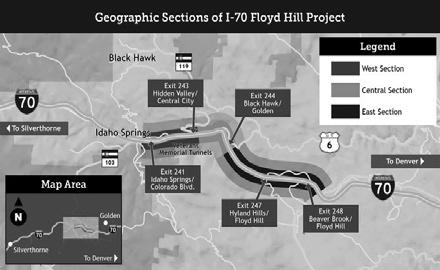
• Add a third westbound I-70 travel lane in this two-lane bottleneck. This new lane will be a full-time, tolled Express Lane from just west of Homestead Road (Exit 247) through the Veterans Memorial Tunnels to Colorado Blvd./Idaho Springs (Exit 241);
• Rebuild bridges due to use, wear and tear and heavy usage;
• Construct a missing 2-mi. section of the frontage road between U.S. 6 and the Hidden Valley/Central City Parkway interchanges, which will improve emergency response;
• Build an extended on-ramp from U.S. 6 onto eastbound I-70 for slow-moving vehi-
cles to have more room to merge;
• Improve traffic flow and access at interchanges and intersections;
• Improve sight distance and safety by straightening roadway curves;
• Improve the Clear Creek Greenway trail;
• Implement environmental mitigation to enhance wildlife connectivity, air and water quality, stream conditions and recreation; and
• Install two permanent air quality monitors.
“The I-70 Mountain Corridor, particularly at Floyd Hill, is the gateway to Colorado’s mountains and a critical economic and tourism route,” said CDOT I-70 Floyd Hill Project Director Kurt Kionka. “Increasing traffic volumes, tight curves and steep grades — which are often exacerbated by weather — require a project that will improve travel time reliability and safety. By eliminating the bottleneck at Floyd Hill, the project will significantly ease congestion and decrease the number and severity of crashes.”

With construction anticipated to stretch through 2028, CDOT and Kraemer North America are committed to minimizing impacts to residents and motorists. The project will be built in three phases.
Construction will begin on I-70 in the East Section of the project, a 4-mi. stretch that spans from County Road 65 to the bottom of Floyd Hill. Over the summer of 2023, crews will focus on building the work zone, excavation, wall construction, drainage work and rock scaling and blasting to create room for roadway improvements. Crews will perform rock blasting and scaling for 20 minutes and then reopen the roadway, but motorists can anticipate up to 45 minutes of delays. Blasting is anticipated to occur two times per week through early 2024.
During construction, the existing travel lanes will be maintained in each direction of I-70 during peak travel hours. However, overnight lane closures on I-70 will occur semi-regularly. Work will conclude in late 2028.
(All photos courtesty of CDOT).

Page 4 • July 2, 2023 • www.constructionequipmentguide.com • Four Corners States Supplement • Construction Equipment Guide
Colorado officials, including Clear Creek County Commissioner Randy Wheelock, U.S. Sens. Michael Bennet and John Hickenlooper, Gov. Jared Polis, and CDOT Executive Director Shoshana Lew throw a ceremonial first shovelful of dirt at an Interstate 70 groundbreaking event.
The I-70 Floyd Hill Project will be constructed in three sections — East, Central and West.
(L-R): Gov. Jared Polis, U.S. Sen. Michael Bennet and U.S. Rep. Joe Neguse listen to the details of the Interstate 70 expansion project from CDOT Executive Director Shoshana Lew.
This rendering shows the new configuation of the Colorado highway when construction is completed.
Utah’s EV Committee Conducts Its Inaugural Meeting
In the month of June, the Utah Electrification of Transportation Infrastructure Steering Committee met for the first time.
The group is tasked with guiding Utah to an electric future, with infrastructure that is both sustainable and economical.
“We’re at a tipping point for electrification of transportation,” said UDOT Executive Director Carlos Braceras, who chairs the committee. “Our mission here is to help Utahns live healthier lives by improving air quality while strengthening the economy.”
The Utah State Legislature recently passed a bill to create the steering committee and provide $2.1 million to Utah State University’s Center for Advancing Sustainability through Powered Infrastructure for Roadway Electrification (ASPIRE). The center will lead the charge in developing a community, state and industry transportation action plan to improve air quality while enhancing the economy.
The ASPIRE Engineering Research Center was created in 2020 through a $25 million National Science Foundation grant, renewable to $50 million over 10 years, to accelerate the creation of electrified corridors that will change the nation’s infrastructure as we know it.
“We need tomorrow’s technologies to do this thing right,” said Dr. Regan Zane, director of ASPIRE. “Now is the time to inject innovation into developing the future vision of our communities and transportation systems. This will inform
critical decisions today on infrastructure investments to accelerate our path to clean air and a reduced cost to move people and goods.”
“The question we face now is how we transition to that
electrified future,” Braceras added. “It’s a complicated process that requires careful planning and a coordinated approach across agencies, industries and communities to build a sustainable solution.”
The committee includes representatives from state transportation, transit, environmental quality, energy, and economic development officials as well as industry representatives:
• Carlos Braceras, executive director of the Utah Department of Transportation;
• Bryce Bird, director of the Utah Division of Air Quality;
• Bailey Toolson, state energy program manager of the Office of Energy Development;
• Jay Fox, executive director of the Utah Transit Authority;
• Ryan Starks, executive director of the Governor’s Office of Economic Opportunity;
• Regan Zane, interim chair of the industry advisory board and chair of Utah State University’s Center for Advancing Sustainability through Powered Infrastructure for Roadway Electrification (ASPIRE).
The board also will include a representative from a major power provider to be appointed by the governor. The ASPIRE Center will form an industry advisory board with representation across the impacted industries, communities and stakeholders.
(All photos courtesy of UDOT.)
Trimble Constructing Solar Array Project in Colorado
Trimble announced that the company has commenced construction of a 1.7-megawatt solar array as a renewable energy source at its Westminster, Colo., headquarters. The new solar panels are projected to offset more than 100 percent of the energy consumed by Trimble’s two-building campus in the Westmoor Technology Park, which represents approximately 6-to-7 percent of the company’s total global electricity demand (based on 2021). The installation will be one of the largest distributed solar projects in the city of Westminster.
The 4.4-acre project includes groundmounted solar arrays and raised structures with solar panels to form 170 carports for employees and visitors. Carports will protect vehicles from the weather and provide 49 electric vehicle charging stations powered by the sun. The system has the capacity to provide a maximum estimated annual yield of 2,570,000 kilowatt hours, which is equiv-
alent to consuming roughly 3,500 barrels of oil. The array also has the added bonus of reducing strain on the grid by minimizing Trimble’s reliance on traditional energy sources, especially at times of peak energy demand, which is typically when the sun is shining.
Trimble is working with Boulder, Colorado-based Namaste Solar, an employee-owned, fully integrated solar energy company, to design and build the project. Several of Trimble’s solutions will be used in the construction of the project, including robotic total stations for surveying and site layout as well as machine control and guidance for pile driving.
“We applaud Trimble’s commitment to reducing its carbon footprint by investing in clean renewable solar energy,” said Rachel Mountain, co-owner and director of commercial and industrial sales of Namaste Solar. “In the face of climate change and rising energy costs, Trimble serves as an inspi-
ration for businesses to source high-quality renewable energy. Not only does this project advance Trimble’s clean energy goals, but it will also drive local economic growth and support over 50 good-paying green jobs in our community.”
The solar array project is part of Trimble’s science-based target commitment to reduce its Scope 1 and Scope 2 greenhouse gas emissions, which includes emissions from the company’s facilities and vehicles, by 50 percent by 2030 (from a 2019 baseline) and to achieve 100 percent annual sourcing of renewable electricity by 2025.
“We feel a heightened responsibility to be more sustainable and to help our customers drive sustainability for the benefit of our planet and future generations,” said Rob Painter, CEO of Trimble. “We are committed to pursuing innovative renewable energy solutions in terms of their environmental benefit. This includes on-site generation of
renewable energy from solar, which we are implementing or pursuing across a number of our global sites.”
About Trimble Westminster

Trimble opened its operations with 40 employees located at the Church Ranch Office Center in Westminster in September 2000. The initial focus for the location included the strategic development of the architecture, engineering, construction (AEC) and mapping and geographic information systems (GIS) markets.

About Namaste Solar
Founded in Colorado in 2005, Namaste Solar is a fully integrated solar energy company providing services from design to installation to ongoing operational support. It works with homeowners, businesses, municipalities, universities, hospitals, utilities, and community solar developers.
Construction Equipment Guide • Four Corners States Supplement • www.constructionequipmentguide.com • July 2, 2023 • Page 5
The Utah State Legislature recently passed a bill to create the steering committee and provide $2.1 million to Utah State University’s Center for Advancing Sustainability through Powered Infrastructure for Roadway Electrification (ASPIRE).

Page 6 • July 2, 2023 • www.constructionequipmentguide.com • Four Corners States Supplement • Construction Equipment Guide

Construction Equipment Guide • Four Corners States Supplement • www.constructionequipmentguide.com • July 2, 2023 • Page 7
ADOT, Ames Utilize Best Use of Technology, Innovation
prouder of what this improvement has accomplished for those who rely on this critical route for passenger and commercial traffic,” said Greg Byres, ADOT state engineer and deputy director of transportation. “ADOT engineers and the contractor used innovative design and construction approaches to create a safer and more reliable US 60 for decades to come.”
Completed in 2022, the $25.3 million project built the new bridge next to the one it replaced, with traffic con-
tinuing to use the old bridge until the new bridge opened.
Among other innovative approaches used:
• ADOT used a bid-alternative method for design, which allowed the contractor to determine economical and supportive foundation systems for each of the bridge’s three piers while taking into account the mountainous terrain;
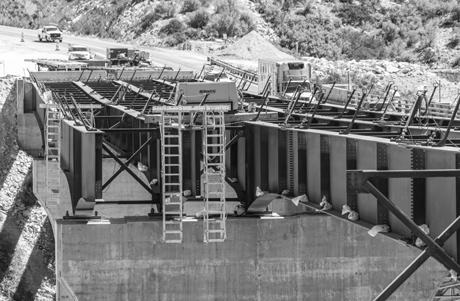
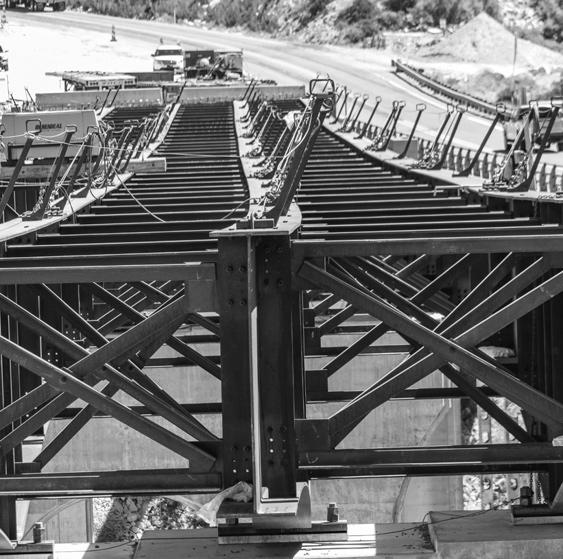
• To create retaining wall structures up to 30 ft. high, ADOT engineers developed design standards and specifications for a micro-pile foundation system using highstrength, small-diameter steel rods;
• A temporary access road was built to the floor of the steep canyon to provide access for heavy equipment, including a 400-ton crane that placed girders atop the piers, the tallest of which is 138 ft.; and

• ADOT partnered with Desert Botanical Garden in Phoenix to temporarily remove and then return hedge-
unique to the project site.
“U.S. 60 is a critical route for passenger vehicles and commercial traffic, including heavy loads from mines in the area,” said ADOT Southeast District Engineer Bill Harmon. “By completing this new bridge at Pinto Creek, we’re making sure the highway will remain reliable and safe for decades to come.”
Page 8 • July 2, 2023 • www.constructionequipmentguide.com • Four Corners States Supplement • Construction Equipment Guide
hog cactuses
(All photos courtesy of Arizona Department of Transportation.)
ADOT used a bid-alternative method for design, which allowed Ames to determine economical and supportive foundation systems for each of the bridge’s three piers; developed design standards and specifications for a micro-pile foundation system using high-strength, small-diameter steel rods.
The $25.3 million project built the new bridge next to the one it replaced, with traffic continuing to use the old bridge until the new bridge opened.
To create retaining wall structures up to 30 ft. high, ADOT engineers developed design standards and specifications for a micro-pile foundation system using high-strength, small-diameter steel rods.
PINTO from page 1
Local Officials Celebrate Completion of Wildlife Project
The Colorado Department of Transportation, Colorado Parks and Wildlife, Federal Highway Administration, Bureau of Land Management, Northwest Colorado Transportation Planning Region and other partner agencies celebrated the completion of the Colorado Highway 13 Reconstruction and Road Widening and Wildlife Underpass project.
The road safety project is located on CO 13 from north of Craig to the Wyoming border.


During construction, crews reconstructed the roadway, including full depth reclamation of existing asphalt. The work created a stronger, more even foundation. Crews also added 8-ft. shoulders, corrected substandard geometry and placed rumble strips, along with a wildlife underpass, detection system and wildlife fencing.




Agency representatives gave spoken remarks on June 8, followed by a tour of two significant wildlife safety improvements.

After the event, Colorado Gov. Jared Polis emphasized the benefits of the project.
“We are improving rural roads across Colorado and these important investments are helping Coloradans and visitors get where they are going quicker and safer while
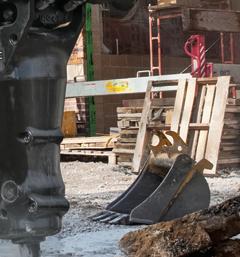

protecting wildlife and avoiding costly wildlife-vehicle collisions,” said Polis.










At the celebration, CDOT Executive Director Shoshana Lew noted how the project is part of a larger effort to improve rural state roadways.
“Completing this project reflects the priority of the rural repaving program in CDOT’s 10-Year plan, which has made unprecedented investments in these critical but secondary routes,” said Lew. “These roadways are so important for providing redundancy in our system and the ability to bypass the interstates when necessary, and to have connectivity for rural communities.”
The project reconstructed CO 13 to meet current design standards, including wider shoulders, drainage improvements, a wildlife underpass, wildlife detection system and wildlife fencing. These improvements are designed to reduce wildlife-vehicle collisions, including a wildlife underpass and a detection system. Work on the project took place in 2021 and 2022.

“I am so thrilled to be in Craig to celebrate this project,” said Transportation Commissioner Kathy Hall. “CO 13 is a critical roadway for Northwest Colorado and serves as an important connector between
Interstates 70 and 80 on Colorado’s Western Slope. These safety improvements will make traveling easier and safer for everyone from families to business owners to freight operators.”



Before the project, CO 13 had a high incidence of single vehicle run-off crashes, head-on crashes and wildlife collisions. These high crash rates were directly related to the substandard roadway geometry, lack of shoulders and adequate recoverable slopes and lack of wildlife fencing. Due to its substandard nature, frequent safety closures have previously been necessary due to inclement weather and crashes; alternative routes require several hours of out-of-direction travel.
“This is an exciting day,” said Federal Highway Administration Deputy Division Administrator Andrew Wilson, noting the new rumble strips, shoulders and wildlife fencing designed to reduce the number of accidents on the roadway. “New safety improvements are anticipated to reduce delays of passenger vehicle travelers and the number of accidents related to poor commercial vehicle traction.”
The project is in cooperation and partnership with Colorado Parks and Wildlife












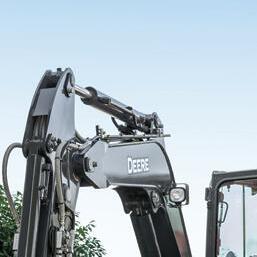

(CPW), as the area is a popular corridor for wildlife. CDOT designed the project to reduce wildlife collisions while maintaining wildlife movement connectivity, including an arch bridge underpass for wildlife to safely travel underneath the roadway, as well as a section of roadway now equipped with a wildlife radar detection system. The detection system is connected to warning signage that will activate when an animal is detected entering the roadway. Newly placed high wildlife exclusion fence will guide animals to the underpass and radar detection area. On Thursday, officials toured the underpass and detection system.
“CDOT and CPW worked together to ‘think outside the box' and design the best wildlife safety improvements along CO 13,” said Colorado Parks and Wildlife Assistant Area Wildlife Manager Mike Swaro. “It was important to incorporate solutions because some of the largest migratory herds of mule deer and elk in Colorado—and perhaps the western United States—migrate through this area. This can mean as many as tens of thousands of animals need to cross CO 13 and make 60-70 mile migrations east to west from as far as the Continental Divide.”
Construction Equipment Guide • Four Corners States Supplement • www.constructionequipmentguide.com • July 2, 2023 • Page 9 800-646- H 6636 onnen.com @honnenequipment
Contractors Digging Deep for Ventilation Shaft Construction
CARLSBAD, N.M. (AP) The U.S.
Department of Energy says it’s making progress on a new ventilation shaft at the nation’s only underground nuclear repository that will allow the facility to ramp up operations as it disposes of tons of waste from decades of research and bomb making.
Contractors have dug more than a third of a mile into the New Mexico desert to build the shaft and are approximately 250 ft. from reaching the final depth.


Ventilation at the Waste Isolation Pilot Plant has been an issue since 2014, when a radiation release contaminated parts of the underground facility and forced an expensive, nearly three-year closure. It also delayed the federal government’s multibillion-dollar cleanup program and prompted policy changes at national laboratories and defense-related sites across the U.S.
Carved out of an ancient salt formation approximately half a mile (800 m) deep, the subterranean landfill located outside of Carlsbad received its first shipment of radioactive waste in 1999. The idea is that the shifting salt will
eventually entomb the waste.
Officials said approximately 13,000 yds. (11,887 m) of concrete were used to line part of the new utility shaft, while the remainder will be lined with steel mesh and bolts to keep the salt walls in place.
The work involves geological mapping, drilling and blasting before all the material is excavated to make way for the shaft.
Officials said the whole ventilation system is expected to be done by mid-2025 and will triple the air flow.
Environmental groups and nuclear watchdog groups have voiced concerns that the ventilation project could lead to further expansions of the repository.
(Photo courtesy of U.S. Dept. Of Energy.)

Page 10 • July 2, 2023 • www.constructionequipmentguide.com • Four Corners States Supplement • Construction Equipment Guide

Construction Equipment Guide • Four Corners States Supplement • www.constructionequipmentguide.com • July 2, 2023 • Page 11 FOUR CORNERS PUBLISHING 2023 Issue Closing Publishing 16 July 19 July 30 18 August 16 August 27 20 September 13 September 24 Issue Closing Publishing 22 October 11 October 22 24 November 8 November 19 26 December 6 December 17




Page 12 • July 2, 2023 • www.constructionequipmentguide.com • Four Corners States Supplement • Construction Equipment Guide
























































